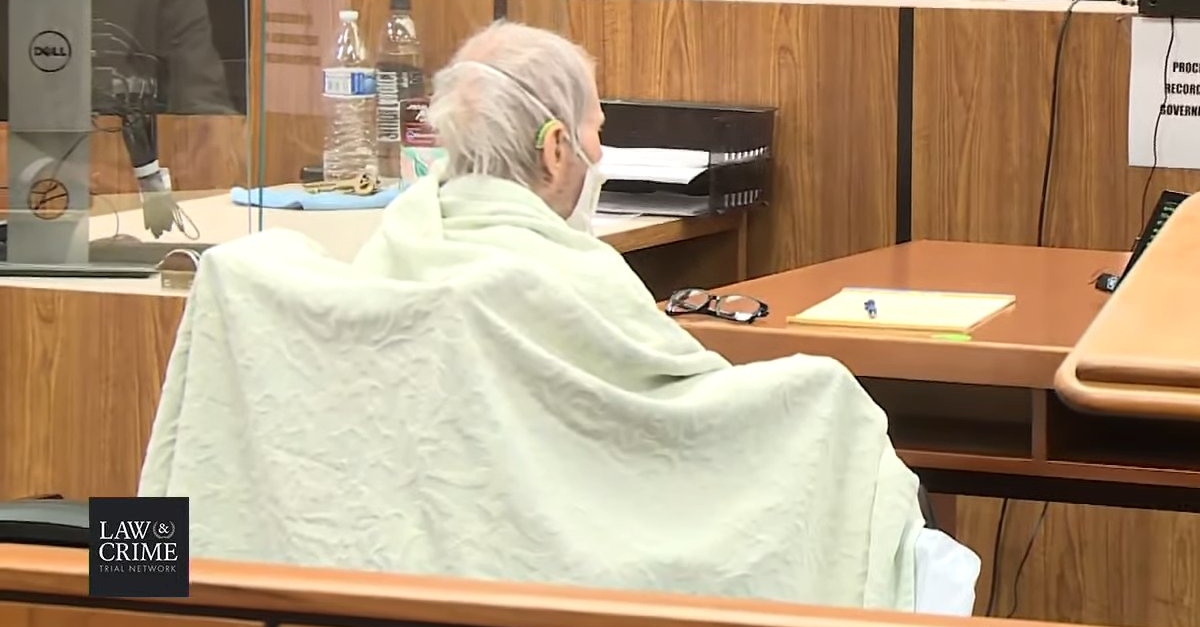
Robert Durst
Murder defendant Robert Durst, 78, returned to court on Monday after being hospitalized from what his attorneys describe as dire medical problems. Judge Mark E. Windham decided that trial in the 2000 execution-style murder of Susan Berman, 55, is going forward nonetheless. Both sides argued at the beginning of court about the appearance of Durst, who showed up to court in jail clothes and has attended court with a wheelchair labeled as belonging to the jail.
Durst was also noticeably covered in a blanket.
#RobertDurst –
Again defense objecting that the jury will know Durst is in custody by wearing jail clothes. HOWEVER, his wheelchair has Property of Los Angeles Jail on it. Jury has seen that every day. @LawCrimeNetwork pic.twitter.com/ftPL4vJy7B— Cathy Russon (@cathyrusson) June 14, 2021
#RobertDurst – LIVE NOW: Jury is in. Durst is covered in a blanket. @LawCrimeNetwork pic.twitter.com/fNqmQ1MGwD
— Cathy Russon (@cathyrusson) June 14, 2021
Monday’s court hearing was yet another surreal development in a story that spans several decades. The prosecution has been trying to show that the defendant killed Berman because of what she knew about the 1982 disappearance of Durst’s wife Kathleen Durst (née McCormack). The defense said defendant Durst did discover Berman at her home, but he only fled in a panic, not because he was responsible. Durst would move to Texas, and kill and dismember his neighbor Morris Black. Durst’s defense back then maintained he was just protecting himself and got him acquitted on the murder charge. Black’s head was never found.
The trial was stalled last year because of the COVID-19 pandemic. His defense more recently tried to postpone it further, saying Durst has bladder cancer. Windham sided with prosecutor John Lewin, who argued the defense’s goal was to make the trial “go away.” In other words, attorneys were accused of trying to run out the clock, so to speak.
Windham sent jurors home early on Thursday. Durst was in the hospital, he said.
“Mr. Durst is not here,” he said. “We understand he is in the jail hospital because of some incident this morning involving his health.”
Lewin once again told the judge on Monday that Durst was on tape talking about faking dementia.
#RobertDurst – Prosecutor John Lewin: This doesn’t exist in a vacuum. We have to look at the history. Durst is on tape about faking dementia. He’s on tape about getting Covid so this trial can start over. “He doesn’t want to be here. He doesn’t want this trial to continue.” pic.twitter.com/XAKGWctcUC
— Cathy Russon (@cathyrusson) June 14, 2021
“During criminal trials, jurors are not supposed to be provided with any information indicating that the defendant is incarcerated as, for obvious reasons, it is viewed as prejudicial to the defendant,” Julie Rendelman, a Law&Crime Network analyst and criminal defense lawyer unaffiliated with the case, told Law&Crime in an email. “Therefore, courts avoid allowing the jurors to see a defendant in prison attire, cuffs or anything that would lead them to believe he’s incarcerated. Here, the defendant is insisting he physically can’t change into non-jail clothes. Whether that is simply manipulation on the part of Durst to try to slow down the trial process is unknown. The solution is the right one—simply cover up the jail house clothes. With that said, it seems quite preposterous that nobody raised an issue regarding the wheelchair’s visibility to the jury indicating it was the property of the jail so it seems the cat is already out of the bag so to speak. Either way, I don’t believe the wheelchair (or the jail clothes) will be a winning basis for appeal assuming there is a conviction.”
Adam Klasfeld contributed to this report.
[Screengrab via Law&Crime Network]